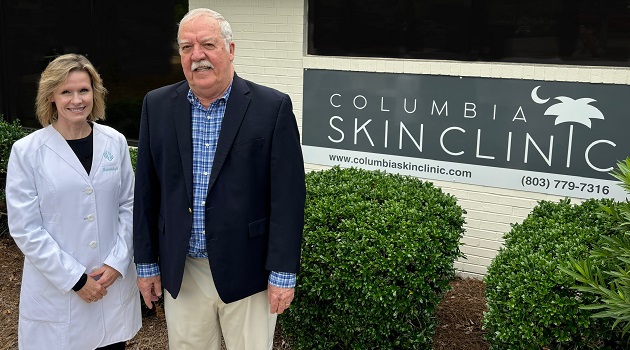By Mike DuBose with Dermatologist Allison Cashman, MD
During our interviews, a heartbroken mother described how her 40-year-old daughter, with young teenagers, was dying from melanoma. The disease originated with an innocent-looking mole, until the colors changed from an even-toned tan to a concoction of tan, black, red, and white. Borders became irregular and expanded beyond normal-sized moles without other symptoms. She ignored the threatening menace until friends at the beach suggested seeing a dermatologist.” When she did, it was too late—stage-IV melanoma! Sadly, as we published this article, we learned she had died.
American Cancer Society determined, “Skin cancers are the most common amongst US cancers where 5.4 million patients are diagnosed annually.” American Academy of Dermatology Association (AAD) reports “20% of the population will develop skin cancer. Most of these conditions are treated successfully if detected early.” The disease can occur in anyone, at all ages, on every body part, including hidden in scalps or mouths. It can surface in varying shapes and sizes, and often is challenging to identify. Jamaica-music-legend Bob Marley (36-years-old) died from melanoma located under his toenail which he initially contributed to be a soccer injury. Dr. Cashman noted, “ New patients we see often report new, non-threatening skin problems. But upon full-body inspections, we sometimes discover pre-cancerous-areas or dangerous melanomas.”
More than 10,000 unnecessarily die from melanoma annually! AAD verified one-million are living with melanoma—detection has doubled since 1982. Good news is five-year melanoma survival rates that hasn’t spread to lymph nodes is 94%. New medications offer longer survival rates and cures in some cases.
What causes skin cancer? Ultraviolet (UV) sun radiation is the most significant risk factor. While reasonable sun exposure with proper protection is healthy, excessive UV-rays damage skin DNA, leading to mutations that can generate cancer. Seniors, who experienced severe sunburns, especially in childhood, are higher risk. Tanning beds, which emit concentrated UV-radiation, are significant threats and can cause irreparable damage far worse than sunlight.
Genetics and mutations may increase risk of developing melanoma or basal cell carcinoma. Families with histories of skin cancer, especially melanoma, are in danger zones.
Individuals with fair skin, light hair, and hazel-, blue-, and green-colored eyes are more susceptible to skin cancer than those with darker skin tones. Lighter skin contains less melanin, which provides some protection against UV-radiation. Patients with histories of frequent sunburns, those who tan poorly, and have large-numbers of moles face increased hazards.
Certain occupations expose individuals to higher UV-radiation levels and skin cancer. Outdoor workers, like farmers, construction laborers, landscapers, and pilots, receive cumulative dangerous UV-radiation levels due to prolonged sun exposure, especially in the South. Individuals who frequently fish, golf, play tennis, and ride in convertible-cars face similar perils.
Skin cancer increases with age, due to the cumulative effects of UV-exposure over time. However, it occurs at any age, especially those with high-sun exposures (like lifeguards) or genetic predispositions. AAD recommends annual skin cancer screening for individuals aged 50+.
While dangers vary by age, skin type, and physical location, men are at higher risk for non-melanoma skin cancer than women but females under 50 are more likely to develop melanoma. Incidence of melanoma in white populations is three-percent while only .001% of African-Americans are affected, but it’s often more deadly.
How to prevent skin cancers?
Use Sunscreen: Apply broad-spectrum sun blockers with SPF-30 or higher daily, even on cloudy days. Reapply every two hours if in the sun for extended periods, or frequently if swimming or sweating. Choosing reputable brands can be overwhelming! The non-profit Consumer Reports conducted scientific tests on many sunscreens. Google “Best Sunscreens by Consumer Reports” to examine their findings. Products made by the same manufacturer can widely vary in protection. Coppertone Water Babies Lotion SPF-50 won the prize for all ages.
Wear protective clothing that covers the skin, including long-sleeved shirts, pants, and wide-brimmed hats.
Seek shade to avoid sun exposure during peak hours (10AM-4PM when UV-radiation is strongest). When our family visits the beach, we always sit under large, shaded canopies and use sunscreen. My son, Blake, shared his infamous saying about preventing sunburns: “The sun always wins!”
Conduct monthly skin examinations of your body using mirrors to identify new or changing moles, spots, or growths. Look for unusual moles with irregular borders, multiple colors, or sizes larger than pencil erasers. Melanoma can suddenly appear without warning!
Schedule annual exams with dermatologists for preventive care and treatments, especially if you or family have histories of skin cancer, numerous moles, or high-sun exposure. Also, ask your dentist to examine your mouth’s interior.
Stop using tobacco products which are linked to skin cancer. Dangers include being exposed to secondary smoke.
Avoid using dangerous tanning beds.
Consume diets rich in antioxidants, vitamins (A-C-E), and minerals, as well as omega-3 fatty acids (found in Salmon and olive oils), to help maintain healthy skin.
Keep your skin hydrated by drinking plenty of water and using moisturizers to maintain skin health and resilience.
Consider genetic counseling when you’re predisposed to skin cancer, to understand risks and genetic testing.
The Bottom Line: We marked this article “Urgent” as part of our family’s purpose to save lives—yours! As Ben Franklin advised, “An ounce of prevention is worth a pound of cure!”
Mike writes for 5 newspapers as part of his purpose “Creating opportunities to improve lives.” Visit his nonprofit website www.mikedubose.com and register to receive his monthly articles or Daily Thoughts plus free access to his books, including “The Art of Building Great Businesses.” The website includes 100+ published articles he has written on business, travel, and personal topics, in addition to health research with Surb Guram, MD, Allison Cashman, MD, and David Hurst, DMV.
Dermatologist Allison Cashman, MD graduated from the Naval Academy and served in the Marine Corps. She earned a B.S. degree in Biology and medical degree from the University of South Carolina School of Medicine. She is a physician with the Columbia Skin Clinic in Irmo, SC (https://columbiaskinclinic.com).



